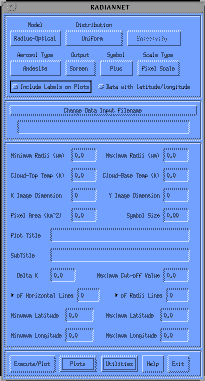 Click on the image to the left to look at a larger version of the IDL widget interface.
Click on the image to the left to look at a larger version of the IDL widget interface.Radiannet is a two-band radiation simulation model. Retrievals of the physical properties of volcanic clouds are processed by adjusting the optical and physical parameters in the radiative transfer models to best fit the observed radiances. In the current program, AVHRR Band 4 and Band 5 brightness temperatures are simulated. The assumptions for using this program are:
 Click on the image to the left to look at a larger version of the IDL widget interface.
Click on the image to the left to look at a larger version of the IDL widget interface.
Radiannet is composed of many different FORTRAN and IDL subroutines.
An IDL widget interface is used to make entering the input parameters easy. The IDL code spawns FORTRAN subroutines,
which does the radiative transfer calculations. The results of the calculations are
transfered back to IDL and output plots are produced.
For information on the detection of volcanic clouds using AVHRR see Two Channel AVHRR Discrimination of Volcanic Clouds.